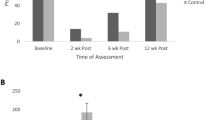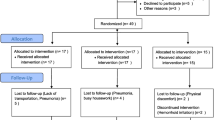Abstract
The aim of the study was to evaluate the effect of pelvic floor muscle (PFM) assessment and training before and after robot-assisted laparoscopic radical prostatectomy (RARP) in improving PFM strength and urinary continence. We performed an analysis of a database of patients who underwent robot-assisted laparoscopic radical prostatectomy (RARP) performed by two urologists from 2011 to 2013. Pelvic floor muscle (PFM) activation and strength were graded by a trained pelvic floor physiotherapist. Patients were given an exercise program, grouped according to the strength of their pelvic floor as graded by assessment, to complete before and after surgery. PFM strength was recorded preoperatively, 4 days post-catheter removal and 4 weeks post-catheter removal. Continence was recorded at 4 weeks postop and was defined as the requirement of no continence aids. A total of 98 patients had RARP and a preoperative physiotherapy assessment plus postoperative appointments at around 1 and 4 weeks post-RARP. The majority of men improved their PFM strength regardless of preoperative strength with no significant predictors of postoperative strength found. Age was the only significant predictor of postoperative incontinence. In this pilot study, a majority of patients increased their pelvic floor strength with time. Pelvic floor physiotherapy is an important modifiable patient factor, which does have an impact in improving patients’ urinary continence by strengthening the pelvic floor muscles. Patient age influences response to pelvic floor physiotherapy.


Similar content being viewed by others
References
Ficarra V et al (2012) Systematic review and meta-analysis of studies reporting urinary continence recovery after robot-assisted radical prostatectomy. Eur Urol 62(3):405–417
Bolton DM et al (2015) Predictors of prostate cancer specific mortality after radical prostatectomy: 10 year oncologic outcomes from the Victorian Radical Prostatectomy Registry. BJU Int 116(Suppl 3):66–72
Chao MW et al (2015) Brachytherapy: state-of-the-art radiotherapy in prostate cancer. BJU Int 116(Suppl 3):80–88
Shamliyan TA et al (2009) Male urinary incontinence: prevalence, risk factors, and preventive interventions. Rev Urol 11(3):145–165
Porena M et al (2007) Voiding dysfunction after radical retropubic prostatectomy: more than external urethral sphincter deficiency. Eur Urol 52(1):38–45
Penson DF et al (2008) 5-year urinary and sexual outcomes after radical prostatectomy: results from the Prostate Cancer Outcomes Study. J Urol 179(5 Suppl):S40–S44
Stanford JL et al (2000) Urinary and sexual function after radical prostatectomy for clinically localized prostate cancer: the Prostate Cancer Outcomes Study. JAMA 283(3):354–360
Srivastava A et al (2013) Effect of a risk-stratified grade of nerve-sparing technique on early return of continence after robot-assisted laparoscopic radical prostatectomy. Eur Urol 63(3):438–444
Messelink B et al (2005) Standardization of terminology of pelvic floor muscle function and dysfunction: report from the pelvic floor clinical assessment group of the International Continence Society. Neurourol Urodyn 24(4):374–380
Basto MY et al (2014) Early urinary continence recovery after robot-assisted radical prostatectomy in older Australian men. BJU Int 114(Suppl 1):29–33
Anderson CA et al (2015) Conservative management for postprostatectomy urinary incontinence. Cochrane Database Syst Rev 1:Cd001843
Centemero A et al (2010) Preoperative pelvic floor muscle exercise for early continence after radical prostatectomy: a randomised controlled study. Eur Urol 57(6):1039–1043
Geraerts I et al (2013) Influence of preoperative and postoperative pelvic floor muscle training (PFMT) compared with postoperative PFMT on urinary incontinence after radical prostatectomy: a randomized controlled trial. Eur Urol 64(5):766–772
Burgio KL et al (2006) Preoperative biofeedback assisted behavioral training to decrease post-prostatectomy incontinence: a randomized, controlled trial. J Urol 175(1):196–201 (discussion 201)
Parekh AR et al (2003) The role of pelvic floor exercises on post-prostatectomy incontinence. J Urol 170(1):130–133
Kumar A et al (2015) Continence outcomes of robot assisted radical prostatectomy in patients with adverse urinary continence risk factors. BJU Int 116(5):764–770
Loughlin KR, Prasad MM (2010) Post-prostatectomy urinary incontinence: a confluence of 3 factors. J Urol 183(3):871–877
Bauer RM et al (2011) Contemporary management of postprostatectomy incontinence. Eur Urol 59(6):985–996
Hirschhorn A, Kolt G, Brooks A (2013) Barriers and enablers to the provision and receipt of preoperative pelvic floor muscle training for men having radical prostatectomy: a qualitative study. BMC Health Serv Res 13(1):305
Sanda MG et al (2008) Quality of life and satisfaction with outcome among prostate-cancer survivors. N Engl J Med 358(12):1250–1261
Author information
Authors and Affiliations
Corresponding author
Ethics declarations
Conflict of interest
All authors declare that they have no conflict of interest
All procedures followed were in accordance with the ethical standards of the responsible committee on human experimentation (institutional and national) and with the Helsinki Declaration of 1975, as revised in 2000 (5). Informed consent was obtained from all patients for being included in the study.
Rights and permissions
About this article
Cite this article
Manley, L., Gibson, L., Papa, N. et al. Evaluation of pelvic floor muscle strength before and after robotic-assisted radical prostatectomy and early outcomes on urinary continence. J Robotic Surg 10, 331–335 (2016). https://doi.org/10.1007/s11701-016-0602-z
Received:
Accepted:
Published:
Issue Date:
DOI: https://doi.org/10.1007/s11701-016-0602-z




